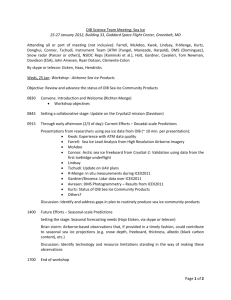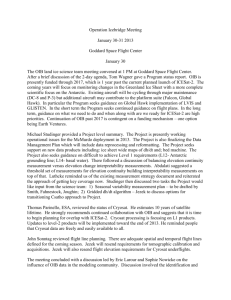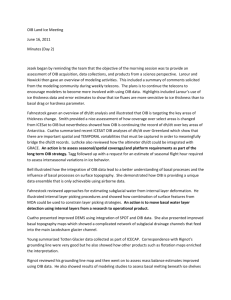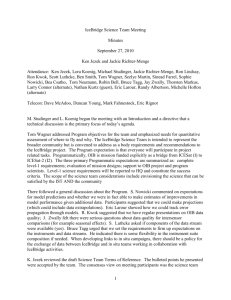Operation IceBridge - Seasonal Measurements
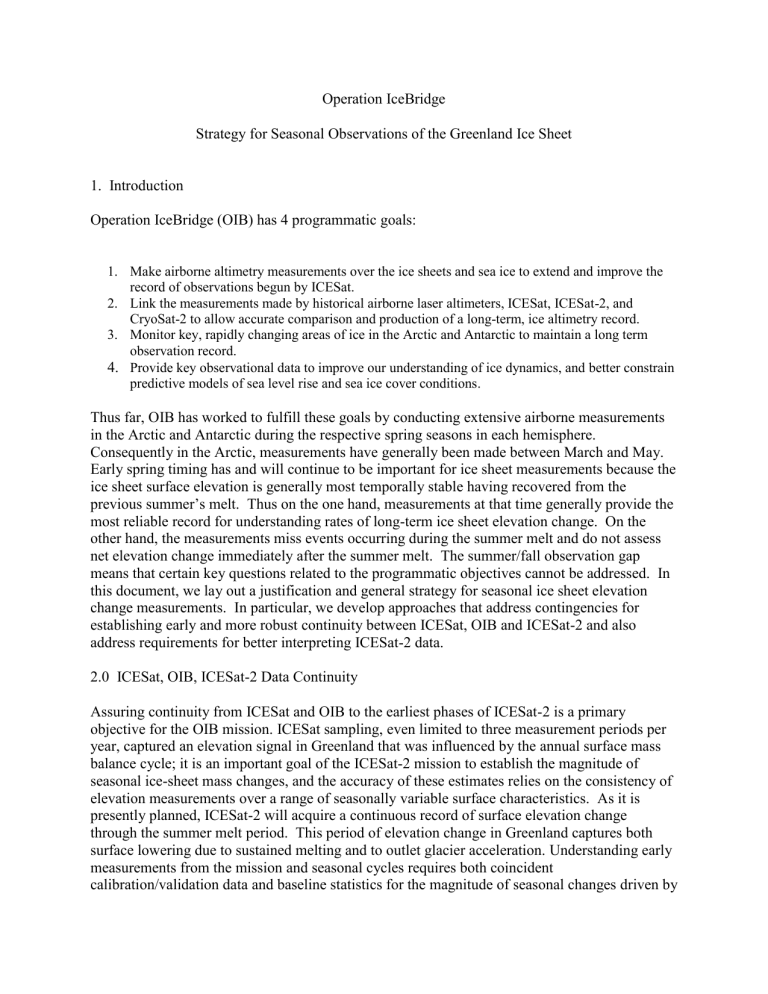
Operation IceBridge
Strategy for Seasonal Observations of the Greenland Ice Sheet
1. Introduction
Operation IceBridge (OIB) has 4 programmatic goals:
1.
Make airborne altimetry measurements over the ice sheets and sea ice to extend and improve the record of observations begun by ICESat.
2.
Link the measurements made by historical airborne laser altimeters, ICESat, ICESat-2, and
CryoSat-2 to allow accurate comparison and production of a long-term, ice altimetry record.
3.
Monitor key, rapidly changing areas of ice in the Arctic and Antarctic to maintain a long term observation record.
4.
Provide key observational data to improve our understanding of ice dynamics, and better constrain predictive models of sea level rise and sea ice cover conditions.
Thus far, OIB has worked to fulfill these goals by conducting extensive airborne measurements in the Arctic and Antarctic during the respective spring seasons in each hemisphere.
Consequently in the Arctic, measurements have generally been made between March and May.
Early spring timing has and will continue to be important for ice sheet measurements because the ice sheet surface elevation is generally most temporally stable having recovered from the previous summer’s melt. Thus on the one hand, measurements at that time generally provide the most reliable record for understanding rates of long-term ice sheet elevation change. On the other hand, the measurements miss events occurring during the summer melt and do not assess net elevation change immediately after the summer melt. The summer/fall observation gap means that certain key questions related to the programmatic objectives cannot be addressed. In this document, we lay out a justification and general strategy for seasonal ice sheet elevation change measurements. In particular, we develop approaches that address contingencies for establishing early and more robust continuity between ICESat, OIB and ICESat-2 and also address requirements for better interpreting ICESat-2 data.
2.0 ICESat, OIB, ICESat-2 Data Continuity
Assuring continuity from ICESat and OIB to the earliest phases of ICESat-2 is a primary objective for the OIB mission. ICESat sampling, even limited to three measurement periods per year, captured an elevation signal in Greenland that was influenced by the annual surface mass balance cycle; it is an important goal of the ICESat-2 mission to establish the magnitude of seasonal ice-sheet mass changes, and the accuracy of these estimates relies on the consistency of elevation measurements over a range of seasonally variable surface characteristics. As it is presently planned, ICESat-2 will acquire a continuous record of surface elevation change through the summer melt period. This period of elevation change in Greenland captures both surface lowering due to sustained melting and to outlet glacier acceleration. Understanding early measurements from the mission and seasonal cycles requires both coincident calibration/validation data and baseline statistics for the magnitude of seasonal changes driven by
both processes. Calibration and validation measurements will undoubtedly begin in the commissioning phase and continue into the early part of the operational mission. Ideally, early measurements would coincide with the Arctic spring to simplify initial data comparisons – but that timing cannot be guaranteed. Indeed is it is possible that a launch during the spring will result in commissioning and early operational phase data acquisitions during or just after summer melt. For that reason, it is important for OIB to acquire some seasonal data to place likely bounds on spring, summer, and fall elevation change. Although there will likely be airborne lidar measurements made concurrent with satellite operations, a single set of observations will not be sufficient to link with previous OIB data sets. Consequently, we recommend at least one and ideally two sets of late summer observations to establish a statistical baseline for seasonal elevation change. These measurements need not be as spatially extensive as typical OIB data collections. For example, a potential campaign could include a repeat of the Jakobshavn Glacier elevation change grid and an ice margin to ice divide line that could cross calibration sites such as the OSU clusters and the Summit survey line. A flight concurrent with an overpass of
Cryosat-2 over percolation and ablation zones late in the melt season would also be of great value.
2.1 Implementation Requirements
Laser altimeters operated with maximum spatial swath coverage are required to fulfill this objective. Geographic coverage is minimally specified as a repeat of the Jacobshavn Glacier grid and overflights of the OSU clusters and Summit survey line to obtain data from ice margin to divide, and two coast-parallel lines on the Northwest coast, one to estimate elevation change near the coast and one near the equilibrium line. At least one and more preferably two seasons of acquisitions will be needed. The season immediately preceeding the ICESat-2 launch has a high priority relative to other OIB land-ice acquisitions. Additional measurements in earlier seasons have a medium to low priority depending on the interval between the campaign and the planned launch date..
3.0 Estimating Surface Melt Magnitude
Current and future efforts aimed at meeting OIB programmatic goals 1 and 2 above for the
Greenland Ice Sheet incorporate or will incorporate satellite laser altimetry data throughout the melt season. Present efforts that connect ICESat elevations from different times of the year with airborne campaigns flown in spring use estimates of the seasonal cycle of surface elevation based on climate reconstruction data from models (Figure 1). These models are used to estimate the amount of surface lowering through the summer melt period; they show, in recent warm years, a strong trend toward much increased mass loss due to melt. While these models are becoming more sophisticated and they produce compelling spatial patterns for surface lowering, there are very few late melt season measurements of elevation available to constrain the true impact of summer melt on surface lowering. To make progress in constraining the sources of error in estimating seasonal impacts on surface elevation, we propose limited late melt season measurements of the type discussed in section 2. These measurements would help constrain the model-based approximations that are used when working with satellite laser altimetry; resulting improvements in the model estimations would then be applicable both backward in time to the
ICESat era, and forward through the ICESat-2 era. Improvements in model estimations and the
ability to distinguish patterns of elevation change related to melt from those related to ice dynamics (discussed below) also contribute to OIB programmatic goals 3 and 4 above. They do so by improving the ability to use surface elevation time series with mass change time series from missions such as GRACE, enhancing observation of both the timing and magnitude of surface mass loss, and by improving our ability to understand the underlying causes of these mass losses.
Figure 1. Summer 2011 (May through August) surface balance expressed as meters of ice.
Balance was calculated by summation of monthly surface balance from two current models.
Note significant differences in the amplitude of the calculated mass changes, as well as some differences in the patterns.
4.0 Understanding the Relationship Between Seasonal Processes and Ice Dynamics
For many Greenland glaciers, there is a strong seasonal variation in calving rate [ Sohn et al.
,
1998], which seasonally modulates the position of the calving terminus. This variation in terminus position can lead to seasonal variation flow speed, which is particularly apparent on
Jakobshavn Isbrae (Figure 2) [ Joughin et al.
, 2012b]. Just as warmer summer temperatures can produce greater calving and seasonal retreat, and warming temperatures over the last decade appear to have produced great calving and sustained retreat [e.g., Howat et al.
, 2008]. Thus, understanding the processes controlling seasonal variation can help improve understanding of the processes that govern long-term retreat. While we have a good understanding that terminus
retreat drives thinning and acceleration, we do not yet have a firm understanding of how a warming atmosphere and ocean processes drive retreat. Although several processes have been proposed (basal melt, ice mélange, water-filled crevasses), the observations to distinguish the relative contributions from each of these processes is lacking [ Joughin et al.
, 2012a]. Thus,
IceBridge observation of seasonal variation, particularly on glaciers with strong seasonal evolution such as Jakobshavn Isbrae, can play an important role improving our knowledge of the processes controlling fast flow consistent with the major objectives of IceBridge.
Eventually it may be possible to accomplish some of these objectives from space using recently available WorldView data. Even if this is the case, a set of high accuracy elevation change measurements such as IceBridge can provide will be necessary for verification and validation of the image based techniques.
Figure 2. Time series of speed on Jakobshavn Isbrae, Greenland. Marker names indicate the approximate distance (e.g., 6 km for M6) upstream from the position of late summer calving front in the early 2000’s.
5.0 References
Howat, I. M., I. Joughin, M. Fahnestock, B. E. Smith, and T. Scambos (2008), Synchronous retreat and acceleration of southeast Greenland outlet glaciers 2000-2006; Ice dynamics and coupling to climate, Journal Of Glaciology , 54 (184), 10.3189/002214308784409017.
Joughin, I., R. B. Alley, and D. M. Holland (2012a), Ice-Sheet Response to Oceanic Forcing,
Science , 338 (6111), 1172-1176.
Joughin, I., B. E. Smith, I. M. Howat, D. Floricioiu, R. B. Alley, M. Truffer, and M. Fahnestock
(2012b), Seasonal to decadal scale variations in the surface velocity of Jakobshavn Isbrae,
Greenland: Observation and model-based analysis, Journal Of Geophysical Research-Earth
Surface , 117 .
Sohn, H. G., K. C. Jezek, and C. J. van der Veen (1998), Jakobshavn Glacier, West Greenland:
30 years of spaceborne observations, Geophysical Research Letters , 25 (14), 2699-2702.
